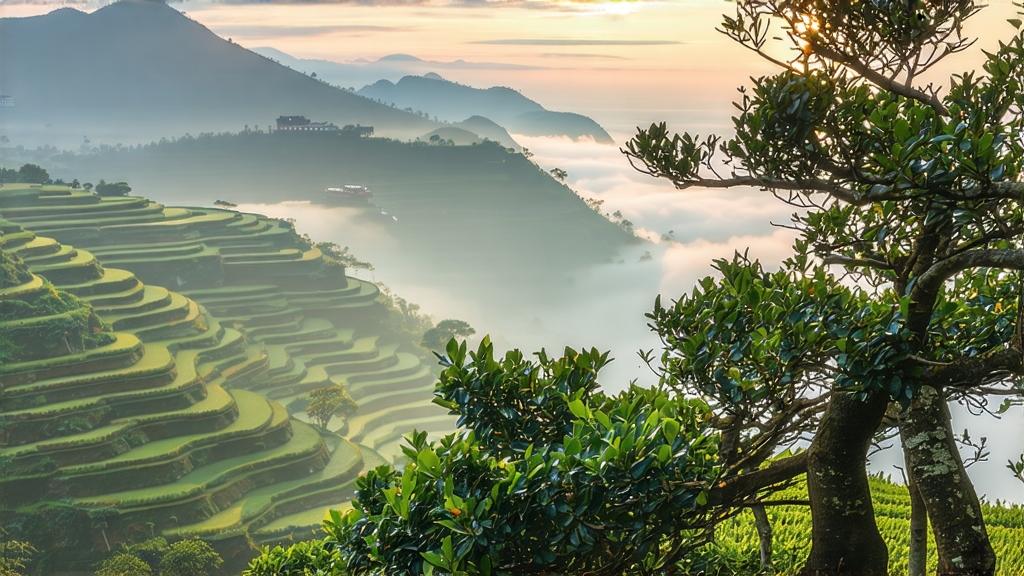
If you have ever walked through a southern-Chinese night market and caught the scent of ripe peach, jasmine, and warm honey drifting from a vendor’s tiny gaiwan, you have already met Phoenix Dancong. To Western palates the name is less familiar than Tie Guan Yin or Da Hong Pao, yet among Chinese tea insiders Dancong is praised as the “perfume of oolong,” a single cultivar capable of evoking lychee, gardenia, almond, or even fresh ginger in one radiant cup. This essay invites you on a complete journey through that cup: the craggy peaks where the trees cling to mineral-rich cliffs, the 24-hour choreography that turns a stiff leaf into aromatic silk, and the gongfu ritual that persuades the leaf to sing its sweetest song.
-
From Song Dynasty Tribute to Modern Muse
Dancong literally means “single grove,” a reference to the ancient practice of selecting individual tea trees whose flavor was so extraordinary that they were cultivated as lone specimens rather than in hedgerows. The first written record appears in 960 CE, when Song emperor Zhao Kuangyin accepted compressed Dancong cakes as tribute from the mountainous Feng Huang (Phoenix) region of eastern Guangdong. By the Ming, the cakes had given way to loose strip-style oolong, and Qing-era merchants shipped it down the Han River to Canton’s Thirteen Factories for export to Southeast Asia and Europe. Today the original mother trees—some exceeding 600 years in age—are protected by the state, yet their descendants, grafted onto younger rootstock, still perfume the high ridges of Phoenix Mountain. -
Micro-terroirs on Cliffs and in Clouds
Phoenix Mountain is not one summit but a labyrinth of granite spires rising between 350 m and 1,400 m. The slopes face every cardinal direction; diurnal swings of 10 °C are common; and the substrate weathers into a sandy, quartz-rich soil that drains like a colander yet holds just enough moisture for the trees’ lateral roots. The result is a library of micro-terroirs, each encouraging a different aromatic expression. Growers therefore classify Dancong not by village alone but by elevation band (low, mid, high cloud), grove name (e.g., Wudong, Da’an, Zhongxin), and finally by the dominant aroma the finished leaf suggests. More than 80 aromatic profiles have been catalogued, but ten “fragrance types” dominate the market: Huangzhi Xiang (orange blossom), Xingren Xiang (almond), Milan Xiang (honey orchid), Yulan Xiang (magnolia), Zhilan Xiang (gardenia), Rougui Xiang (cassia), Youhua Xiang (pomelo flower), Jianghua Xiang (ginger flower), Yashi Xiang (duck-shit—an intentionally misleading name to deter thieves), and the legendary Song Zhong, descended directly from the Song-era mother trees. -
The Living Archive of Old Trees
Unlike the terraced hedges of modern Tie Guan Yin, high-end Dancong still comes from tall, single-trunk trees that resemble Mediterranean olive more than Camellia sinensis. A 200-year-old tree may stand four meters high, its canopy pruned only once a year after the final autumn harvest. Because the roots have drilled deep into fissured granite, the leaf chemistry differs markedly from young plantings: amino acids are higher, polyphenols more polymerized, and the lignin-rich stems lend a natural sweetness that survives repeated infusions. Pickers climb bamboo ladders to pluck only the standard “zhong kai mian” triad: one bud plus two semi-mature leaves whose serrations have begun to blush bronze. Yield is tiny—perhaps two kilograms of finished tea per century-old tree—but concentration compensates for scarcity. -
Crafting the Fragrance: A 24-Hour Drama
Dancong’s processing is a high-wire act between oxidation and aroma fixation. The sequence begins at dusk, when the sun’s angle is low enough to prevent scorching yet the leaf still holds field moisture. After a 30-minute withering under gentle mountain breeze, the leaves are shaken—never kneaded—inside rectangular bamboo drums. This bruises the edges just enough to trigger enzymatic oxidation while keeping the midrib intact. Over the next eight hours the leaf alternates between resting piles and brief re-shaking; experienced artisans listen for the rustle that